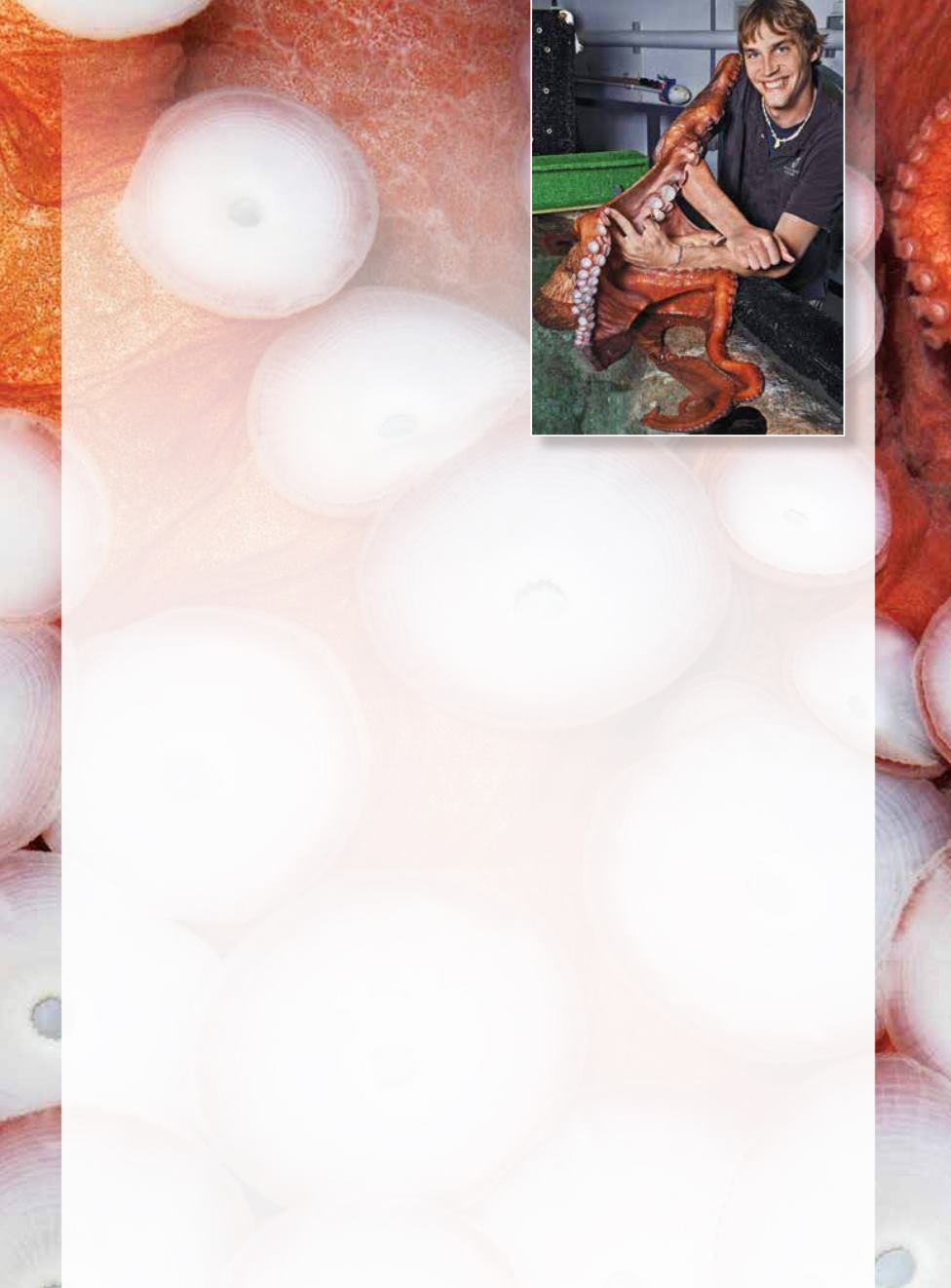
dive slate
//
I
f Mack and the boys stumbled out of John
Steinbeck’s Cannery Row and down the street
into the back door of Monterey Bay Aquarium,
they might mistake it for the clandestine
hatchery of an alien invasion force — think Doc
Ricketts meets exobiology lab. That seemingly
fanciful notion would not be far from the truth.
Throughout dark corridors in holding tanks bathed
in eerie pink and blue LED lights is a growing army
of hatchlings, ravenous juveniles and elusive, shape-
shifting adults that represent some of the most
otherworldly life forms on this planet.
Over the past two years Paul Clarkson, the
aquarium’s curator of husbandry operations, and
his team have been engaged in a reproductive
experiment of unprecedented proportions. Their
goal: to breed and raise more than two dozen species
of cephalopods, the ancient class of mollusks that
includes octopuses, squid and cuttlefishes.
Clarkson describes the breeding program as a
monumental challenge but says it was the only way
to approach a large-scale exhibition. “These animals
for the most part live less than a year. They’re hard to
acquire, expensive and nearly impossible to transport,
and they don’t like each other,” he said, meaning that
they like each other too much — most are cannibals.
“We knew an exhibition would require us to source
animals continually, so we decided to try to bring
their full [life] cycles in house.”
“Tentacles: The Astounding Lives of Octopuses,
Squid and Cuttlefishes” features more than 30 species
of cephalopod that will rotate through a dozen
aquatic displays. The animals hail from disparate
locations ranging from the tropical Indian Ocean to
the frigid, sunless depths of Monterey Bay. Nearly 5
million visitors are expected to view the almost 4,000-
square-foot exhibition.
Among the octopuses showcased are the kaleidoscopic
wonderpus, the highly toxic flamboyant cuttlefish and
the shape-shifting mimic octopus, which can assume
the form and coloration of other marine animals. There
are bioluminescent Hawaiian bobtail squid, which bury
themselves in the sand during the day, and one of the
world’s smallest squid, the northern pygmy, which is
less than an inch long. A life-size model of a giant squid,
which can grow to the length of a greyhound bus, is
splayed overhead along the exhibit’s ceiling.
There is also a pair of giant Pacific octopuses, a
rarely seen chambered nautilus (which may have up
to 90 tentacles) and various deep-sea cephalopods,
including vampire squid collected from Monterey Bay
by the aquarium’s sister organization, the Monterey
Bay Aquarium Research Institute (MBARI). Most of
these animals have never before been exhibited.
Cephalopods were once a dominant form of life on
the planet, and some biologists believe they are poised
for a resurgence. These stealthy marine animals boast
large, intelligent brains, complex nervous systems, highly-
developed senses and the ability to instantaneously
change color, pattern and form in response to stimuli.
They play a crucial role in marine food webs as both
predators and prey in every ocean in the world from the
shallows to the abyssal depths. Humans alone consume
more than 2.2 billion pounds of cephalopods a year.
Though the number of cephalopod species (some
800 and counting) is dwarfed by the more than
30,000 species of fish, biologists suspect that their
biomass is roughly the same, and there is evidence
that biomass is increasing.
Monterey Bay Aquarium’s pioneering work comes
at a time when our knowledge of cephalopods is
undergoing a period of profound discovery. In the last
20
|
SPRING 2014
an alien invasion
“Tentacles” at Monterey Bay Aquarium
COURTESY MONTEREY BAY AQUARIUM


